Physical Address
304 North Cardinal St.
Dorchester Center, MA 02124
A tendon transfer is a reconstructive technique in which the tendon of a functioning muscle is detached, mobilized, and then reattached to another tendon or tendons of a non-functioning muscle, or into bone, to substitute for the action of the non-functioning muscle or tendon.
Tendon transfers in the upper limb are indicated to restore function to paralyzed muscles and tendons following nerve injuries, direct muscle or tendon injuries, and to restore balance to hands affected by neurological or rheumatological diseases.
Basic principles of tendon transfers include soft-tissue and bony equilibrium, full passive range of motion of the involved joints, selection of the most appropriate donor muscle and direction of the transfer.
Timing of tendon transfers can be subdivided into early, conventional, or late.
Upper extremity nerve injuries can be classified into radial nerve palsy, low and high median nerve palsy, low and high ulnar nerve palsy, and combined nerve palsies.
Access video lecture content for this chapter online at Elsevier eBooks+ ![]()
Tendon transfers are reconstructive techniques that will restore motion or balance to the hand due to impaired or absent function of the extrinsic or intrinsic muscle–tendon units of the forearm and hand. In a typical tendon transfer, the tendon of insertion of a functioning muscle is detached, mobilized, and then reattached to another tendon or bone to substitute for the action of a non-functioning muscle–tendon unit. Very occasionally, both the tendon of origin and the tendon of insertion are detached and then reattached at different locations. Unlike a tendon graft, the transferred donor tendon remains attached to its parent muscle. A tendon transfer also differs from a microsurgical free muscle transfer in that the neurovascular pedicle to the muscle of the transferred tendon remains intact.
There are three general indications for tendon transfers in the upper extremity:
To restore function to a paralyzed muscle due to injuries of the peripheral nerves, the brachial plexus, or the spinal cord.
To restore function following closed tendon ruptures or open injuries to the tendons or muscles of the forearm, wrist and hand.
To restore balance to a deformed hand due to various neurological and rheumatological diseases.
Tendon transfers are best conceptualized as a means to restore a lost “function”, rather than a means of substituting for a specific muscle, i.e., restoring strong pinch as opposed to restoring function of the flexor pollicis longus or adductor pollicis. Tendon transfers are performed predominantly following peripheral nerve injuries and therefore will be discussed according to the three specific nerve palsies. However, the general principles described in this chapter apply to all transfers ( Table 25.1 ).
| Soft-tissue and bony “equilibrium” |
| Full passive range of motion of the involved joints |
| Donor muscle-tendons must be expendable |
| Adequate amplitude of the donor muscle |
| Direct line of pull |
| Single function for each transferred tendon |
| Synergy of the transfer |
Steindler first suggested that tendon transfers cannot glide through edematous or scarred soft tissues, nor can they flex or extend stiff metacarpophalangeal (MCP) and proximal interphalangeal (PIP) joints. He therefore advocated that tendon transfers be delayed until “tissue equilibrium” had been restored. Before a tendon transfer is performed, all fractures should be healed or rigidly fixed by internal fixation. Chronic scarred skin and subcutaneous tissues or skin grafts in the projected line of pull of a tendon transfer should be excised and the defect resurfaced with a flap that is allowed to heal so the scars become mature. If secondary tendon transfers are likely to be necessary, initial split-thickness skin grafting of soft-tissue defects of the hand and forearm, simply to achieve a healed wound, should be avoided if possible. Instead, a pliable flap ideally of skin and subcutaneous tissues should be considered, either as delayed primary coverage using pedicled flaps such as the groin flap and reverse radial forearm flap or free flaps such as the lateral arm flap, contralateral radial forearm flap, scapular flap, latissimus dorsi flap, and anterolateral thigh flap. Occasionally, silicone rods can be placed at the time of flap coverage, either beneath or through the subcutaneous fat of a transferred flap to create a smooth tunnel through which a tendon transfer may be later passed. The span of the thumb–index finger webspace should be maintained by splinting, especially following median nerve injuries. If a secondary adduction contracture has developed, this should be released by a Z-plasty, skin grafting, or transposition flap, and release of the adductor pollicis if needed, prior to any opposition tendon transfer. Full passive range of motion of the MCP and PIP joints should be achieved by physical therapy and dynamic splinting prior to any tendon transfer. Preliminary capsulotomies of the MCP and PIP joints or tenolysis of adherent flexor or extensor tendons may occasionally be required if dynamic splinting fails to achieve adequate joint mobility.
The muscle–tendon unit selected as a potential donor for transfer must be expendable. Its sacrifice must not create an important new deficit. For example, the ring finger flexor digitorum superficialis (FDS) tendon may be used to correct MCP joint hyperextension (claw deformity) in patients with a low ulnar nerve palsy, but it is not expendable in patients with a high ulnar nerve palsy who have no functioning flexor digitorum profundus (FDP) tendon to the ring finger. The selection of a muscle–tendon unit as a tendon transfer may also be influenced by the patient's occupation. For example, the flexor carpi radialis (FCR) may be a more appropriate transfer to provide finger extension in a working man rather than the more conventional flexor carpi ulnaris (FCU) transfer, since the FCU provides the important function of flexion and ulnar deviation of the wrist needed in work activities such as hammering. More importantly, if multiple tendon transfers are required, a minimum of one wrist flexor, one wrist extensor, and one extrinsic flexor and extensor tendon to each digit should always be retained.
Full passive range of motion of the MCP and PIP joints should be achieved before considering any tendon transfers.
The selected donor muscle–tendon unit must be expendable.
One wrist flexor, one wrist extensor, one extrinsic flexor tendon, and one extrinsic extensor tendon to each digit should always be retained.
In selecting the most appropriate donor muscle–tendon, the surgeon must consider not only the strength of the muscle to be transferred, but also the native strength of the now paralyzed muscle or muscles and the strength of the antagonist muscle. Brand has emphasized that the maximum potential force of a muscle is directly proportional to its physiologic cross-sectional area. It has been calculated that a muscle can produce a force of 3.65 kg per square centimeter of its cross-sectional area. This potential force is maximal when the muscle is at its resting length which is defined as the position midway between the length when it is fully stretched passively and when it is fully contracted.
The potential amplitude or excursion of a donor muscle–tendon unit must also be sufficient to restore the specific lost function. The finger flexors have an amplitude of 70 mm, the finger extensors 50 mm, and the wrist flexors and extensors 33 mm. The tenodesis effect of wrist flexion or extension may potentially increase the effective amplitude of a tendon transfer by 20 mm ( Fig. 25.1 ). Excursion of a donor muscle may also be increased by extensive release of its surrounding fascia and is best exemplified by transfer of the brachioradialis (BR) muscle. The distal portion and tendon of the BR muscle are surrounded by dense fascia. Release of these fascial attachments will add an additional 2–3 cm of passive excursion.
Amplitude of donor muscle–tendon units:
Finger flexors – 70 mm;
Finger extensors – 50 mm;
Wrist flexors and extensors – 33 mm.
The potential amplitude of a donor wrist extensor tendon used to restore finger flexion may be increased by 20 mm to produce an effective amplitude of 50 mm by the tenodesis effect of wrist extension.
The potential amplitude of a donor wrist flexor tendon used to restore finger extension can be increased by 20 mm to produce an effective amplitude of 50 mm by the tenodesis effect of wrist flexion.
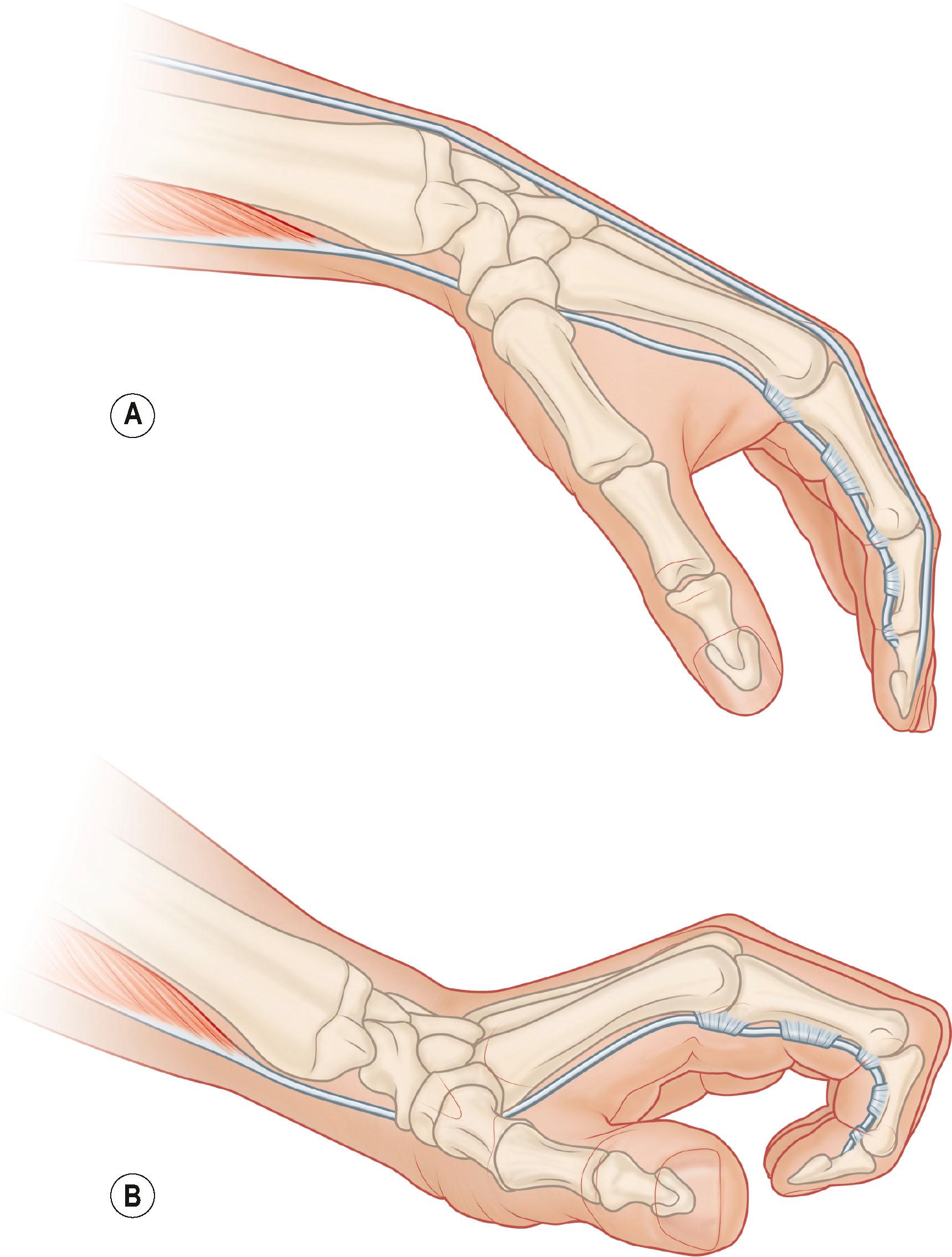
A tendon transfer should pass in a direct line from the origin of the donor muscle to its new insertion. Unless early tendon transfers are being performed, when there is still a chance of reinnervation following nerve repair, the recipient tendons should be divided proximal to the site of the tendon juncture to create a more direct line of pull (end-to-end) rather than producing a Y-shaped end-to-side juncture. Tendon transfers should only act across one joint and only perform one single function. This maintains the “integrity” of the donor muscle. However, a transfer may be inserted into several recipient tendons as long as they each perform the same function in adjacent digits. Finally, the donor muscle selected should preferably be synergistic with the function of the muscle to be restored or at least be potentially retrainable.
The surgeon has to determine the specific functions to be restored, select the appropriate donor muscle–tendon units, and decide on the timing of the tendon transfer. To make this selection, every muscle still functioning in the forearm and hand should be tested by manual muscle testing to document which ones are functionning and their strength graded. From this list of functioning muscles, only those that are expendable are available as donor transfers. The specific functions of the hand that need to be restored are then listed in order of priority. The final step is to match the available donor muscles with the functions that need to be restored, based on the force, amplitude, and direction of the various muscles available. Arthrodesis of a more proximal joint such as the wrist may occasionally need to be considered to release a wrist flexor or extensor tendon for transfer. Transfers that require postoperative immobilization with the wrist in flexion are usually performed at a first stage. Those transfers requiring postoperative immobilization with the wrist in extension are performed at a second stage.
Document which muscles are functioning and their individual strengths.
Only the expendable muscles in this group of functioning muscles can be considered as potential donor transfers.
List the specific hand functions that need to be restored, in order of priority.
Match the available expendable donor muscles with the hand functions that need to be restored.
Consider wrist fusion to release a donor wrist flexor or extensor tendon.
Timing of tendon transfers may be classified as early, conventional, or late. A conventional tendon transfer is usually performed after reinnervation of the paralyzed muscle fails to occur by 3 months after the expected time of reinnervation based on the rate of nerve regeneration of 1 mm/day. Brand, Omer, and Burkhalter have advocated “early” tendon transfers in certain circumstances, in which a tendon transfer is performed simultaneously with the nerve repair or before the expected time of reinnervation of the muscle. This “early” tendon transfer therefore serves as a temporary substitute for the paralyzed muscle until reinnervation occurs, by acting as an “internal splint”. If reinnervation is suboptimal, the “early” tendon transfer acts as a helper to augment the power of the muscle and if reinnervation fails to occur, it then acts as a permanent substitute.
The success of any tendon transfer depends entirely on preventing scarring or adhesions along the path of the transferred tendon. Incisions should be carefully planned prior to elevation of the tourniquet so that the final tendon junctures lie transversely beneath skin flaps rather than lying immediately beneath and paralleling the incisions. The donor muscle should be carefully mobilized to prevent damage to its neurovascular bundle which usually enters in the proximal third of the muscle. The transferred tendon should glide in a tunnel through the subcutaneous tissues and not cross bone devoid of uninjured periosteum nor pass through small fascial windows. Only the distal end of the tendon should be grasped with surgical instruments and care taken to prevent desiccation of the tendon or the surrounding tissues. Tendon junctures are performed using a Pulvertaft weave technique when possible. The donor and recipient tendons are sutured under normal tension and after one or two non-absorbable sutures have been inserted, the tension of the transfer is checked by observing the flexion and extension of the digit during tenodesis of the wrist. Postoperatively the hand is immobilized in the desired position for 3–4 weeks, at which time gentle active range of motion exercises are started, usually under the supervision of a therapist, but the hand is protected for a further 3 weeks in a lightweight protective splint.
Carefully design the incisions not only to allow dissection of the donor muscle–tendon unit, but also so that the tendon junctures lie beneath an elevated skin flap, rather than immediately beneath the incision, in order to prevent adhesions that will restrict gliding of the tendon transfer.
The recipient tendon/s should be fully distracted to produce maximal function of the recipient tendon/s and the donor tendon transfer should be sutured at its resting length to the recipient tendon/s using a Pulvertaft weave technique.
Correct tensioning of the tendon transfer is checked by observing flexion and extension of the digits or abduction and adduction of the thumb during tenodesis of the wrist.
The functional motor deficit in radial nerve palsy consists of inability to extend the wrist, inability to extend the fingers at the MCP joints, and inability to extend and radially abduct the thumb ( Fig. 25.2 ). However, the most significant disability is that patients are unable to stabilize their wrist, so that transmission of flexor power to their fingers is impaired resulting in marked weakness of grip strength.
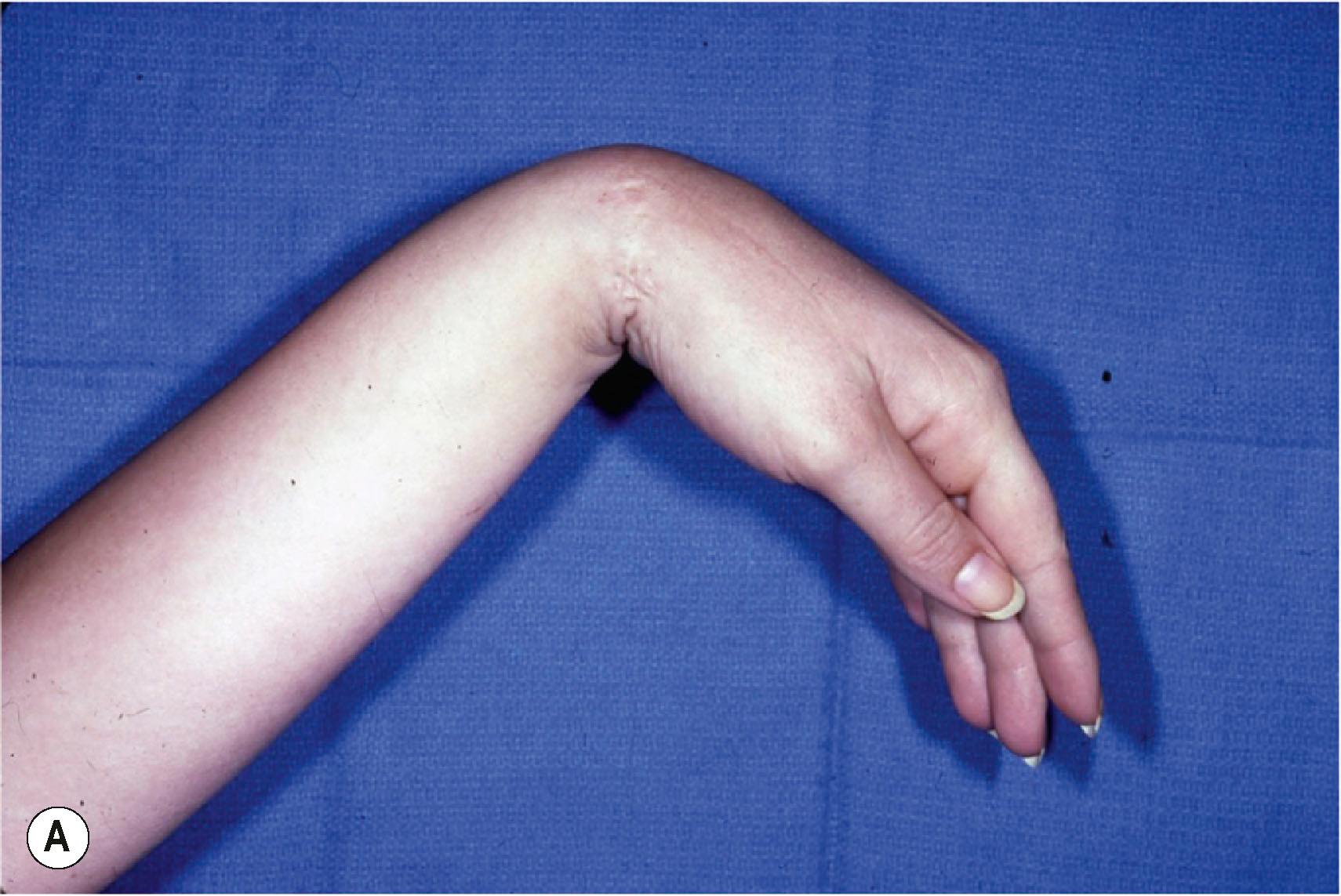
Tendon transfers are therefore required to provide wrist extension, extension of the fingers at the MCP joints, and extension and radial abduction of the thumb. Unlike the median and ulnar nerves, sensory loss following radial nerve injury is not functionally disabling unless the patient develops a painful neuroma.
Timing of tendon transfers for radial nerve palsy remains controversial. The two options are either to perform an “early” tendon transfer simultaneously with repair of the radial nerve to act as an “internal splint” to provide immediate restoration of power grip; or more conventionally, to delay any tendon transfers until reinnervation of the most proximal muscles, brachioradialis and extensor carpi radialis longus fails to occur within the calculated time limit. The more proximal the nerve injury, the less likely that functional muscle reinnervation will occur. If the nerve remains in continuity, most surgeons would suggest that 3 months of observation are indicated to await spontaneous recovery in peripheral nerve palsies.
Ring et al . reviewed 24 patients with a complete radial nerve palsy associated with a high-energy humeral fracture. Six of 11 open fractures had a transected radial nerve and none of the five patients who underwent primary repair of the radial nerve recovered any function. All eight nerves that were explored and found to be intact and 9 of 10 unexplored nerves recovered completely, with initial signs of recovery at an average of 7 weeks and full recovery at an average of 6 months. The authors concluded that primary repair of a transected radial nerve associated with a high-energy humerus fracture was very poor, but the prognosis for full recovery of an intact radial nerve, whether the fracture is open or closed, was very good. Mayer and Mayfield reported 39 cases of posterior interosseous nerve (PIN) neurorrhaphy, with complete recovery in 28 and partial recovery in 11 patients. Young et al . studied 51 patients with PIN palsy and only 11 had resolved by 3 months. Of the remaining 40 patients, 20 of the 23 who underwent neurolysis and 10 of the 12 who underwent nerve grafting had excellent or good results. A conflicting study of radial nerve injuries demonstrated useful function in 65%, but only 38% of patients who underwent nerve grafting obtained useful motor function. These studies demonstrate that injury and repair of the radial and PIN nerves can provide significant return of function and should be considered. With extensive nerve gaps or associated soft-tissue injuries or in older patients, the chances of successful reinnervation are much less predictable and it may therefore be more appropriate for these patients to undergo the full set of tendon transfers early. In a patient awaiting return of nerve function, it is important to maintain supple MCP joints capable of full extension and adequate radial abduction of the thumb with appropriate splinting and therapy.
Franke provided one of the earliest descriptions of tendon transfers for radial nerve palsy using the FCU to extensor digitorum communis (EDC) transfer through the interosseous membrane. Capellen in 1899 described the FCR to extensor pollicis longus (EPL) transfer. The pronator teres to extensor carpi radialis longus (ECRL) and the extensor carpi radialis brevis (ECRB) transfer for wrist extension was first reported in 1906 by Sir Robert Jones. Zachary emphasized the importance of retaining at least one wrist flexor, preferably the FCR, to facilitate wrist control. Other authors have suggested that FCU is not an expendable tendon and therefore prefer to use the FCR as the donor tendon to restore finger extension. The advantage of using FCR is that it preserves the important vector of wrist flexion and ulnar deviation which is so important for power grip in a working man. This is particularly true in the patient with a posterior interosseous nerve (PIN) palsy, in which ECRL function is preserved but extensor carpi ulnaris (ECU) activity is lost. This leads to radial deviation of the wrist with attempted wrist extension. Use of the FCU in this setting will therefore increase the radial deviation of the wrist, since only the radially deviating ECRL is preserved.
Several different tendon transfers have been reported for radial nerve palsy but three patterns of transfer have evolved. The use of pronator teres to provide wrist extension has become universally accepted, the only remaining controversy being whether to insert pronator teres into ECRB alone or into both ECRL and ECRB. The three patterns of tendon transfer differ therefore only in the technique of restoring finger extension and thumb extension and radial abduction ( Table 25.2 ).
| Standard FCU transfer | FCR transfer | Boyes superficialis transfer |
|---|---|---|
| PT to ECRB | PT to ECRB | PT to ECRB |
| FCU to EDC | FCR to EDC | FDS of ring finger to EDC long, ring, and small fingers |
| PL to EPL | PL to EPL |
|
In a patient with a radial nerve palsy, the FCU transfer is the author's preferred technique; in the patient with a PIN palsy, the FCR transfer is preferred. Through an inverted J-shaped incision over the ulnar–volar aspect of the distal forearm, the FCU tendon is transected at the wrist crease and released extensively from its fascial attachments up into the middle third of the forearm, taking care not to damage the neurovascular pedicle, using a second incision in the proximal forearm if necessary (see Figs. 25.4 & 25.6 ). Through the same distal incision, the palmaris longus (PL) tendon is transected at the wrist crease and the muscle similarly mobilized into the middle third of the forearm (see Figs. 25.5 & 25.6 ). An S-shaped incision is then made beginning over the volar–radial aspect of the middle third of the forearm and passing dorsally and ulnarly over the radial border of the forearm. The tendon of pronator teres is elevated from the radius in continuity with a 2–3 cm strip of periosteum (see Fig. 25.3 ). The ECRB is transected at its musculotendinous junction if there is no chance of future reinnervation of the wrist extensors. The pronator teres is then re-routed around the radial border of the forearm superficial to the brachioradialis and extensor carpi radialis longus in a straight direction to its insertion into ECRB (see Fig. 25.3 ). The FCU tendon is passed through a subcutaneous tunnel made with a Kelly clamp from the proximal incision used to mobilize FCU, around the ulnar border of the forearm into the dorsal incision, to lie obliquely across the EDC tendons proximal to the extensor retinaculum (see Fig. 25.6 ). Alternatively, the FCU tendon may be passed from the palmar incision to the dorsal incision through a window in the interosseous membrane. If no return of EDC function is to be expected, the EDC tendons can be transected at their musculotendinous junctions so that a more direct line of pull can be achieved. Otherwise an end-to-side juncture is performed. The extensor pollicis longus (EPL) tendon is divided at its musculotendinous junction, removed from the third dorsal extensor tendon compartment, and re-routed through a subcutaneous tunnel from the base of the thumb metacarpal to the volar wrist incision (see Fig. 25.5 ). If the PL is absent, the EPL tendon is included with the EDC tendons and the FCU transfer provides both finger and thumb extension. To prevent a collapse flexion deformity at the carpometacarpal joint of the thumb, tenodesis of the abductor pollicis longus may be necessary. After transection of the APL tendon in the distal forearm, it is looped around the brachioradialis proximal to the radial styloid and sutured to itself with the thumb metacarpal held in extension with the wrist in 30° of extension.
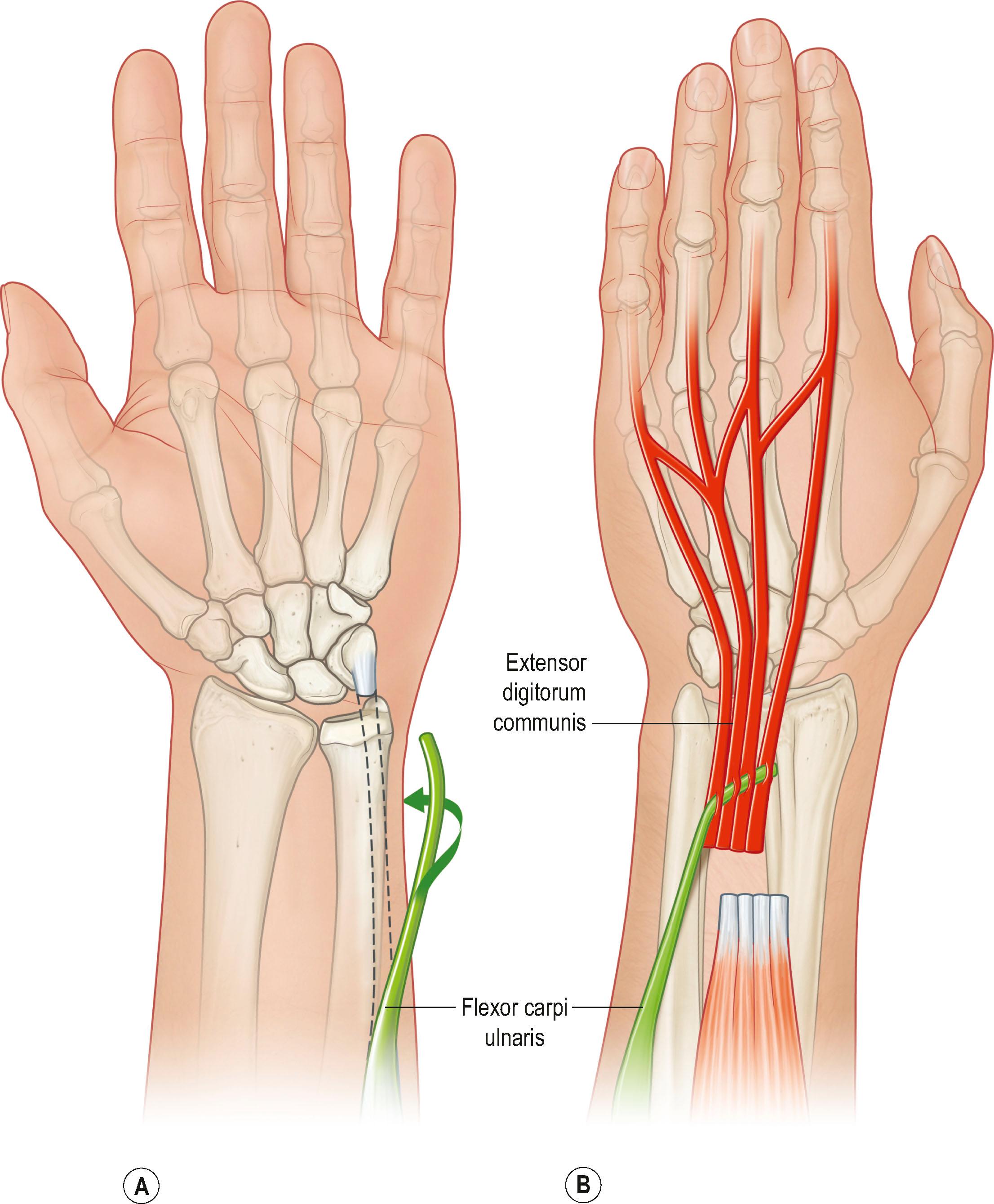
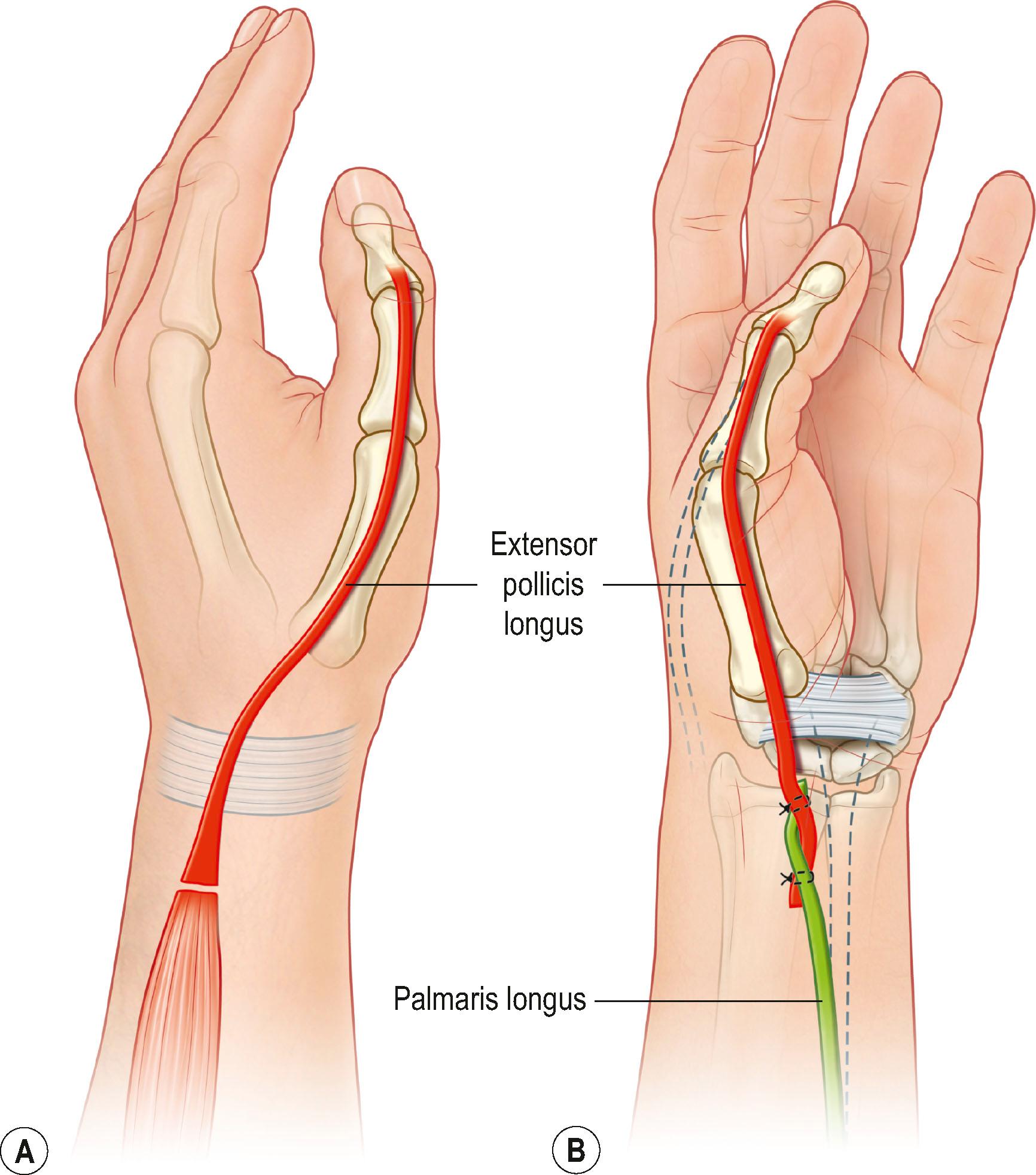
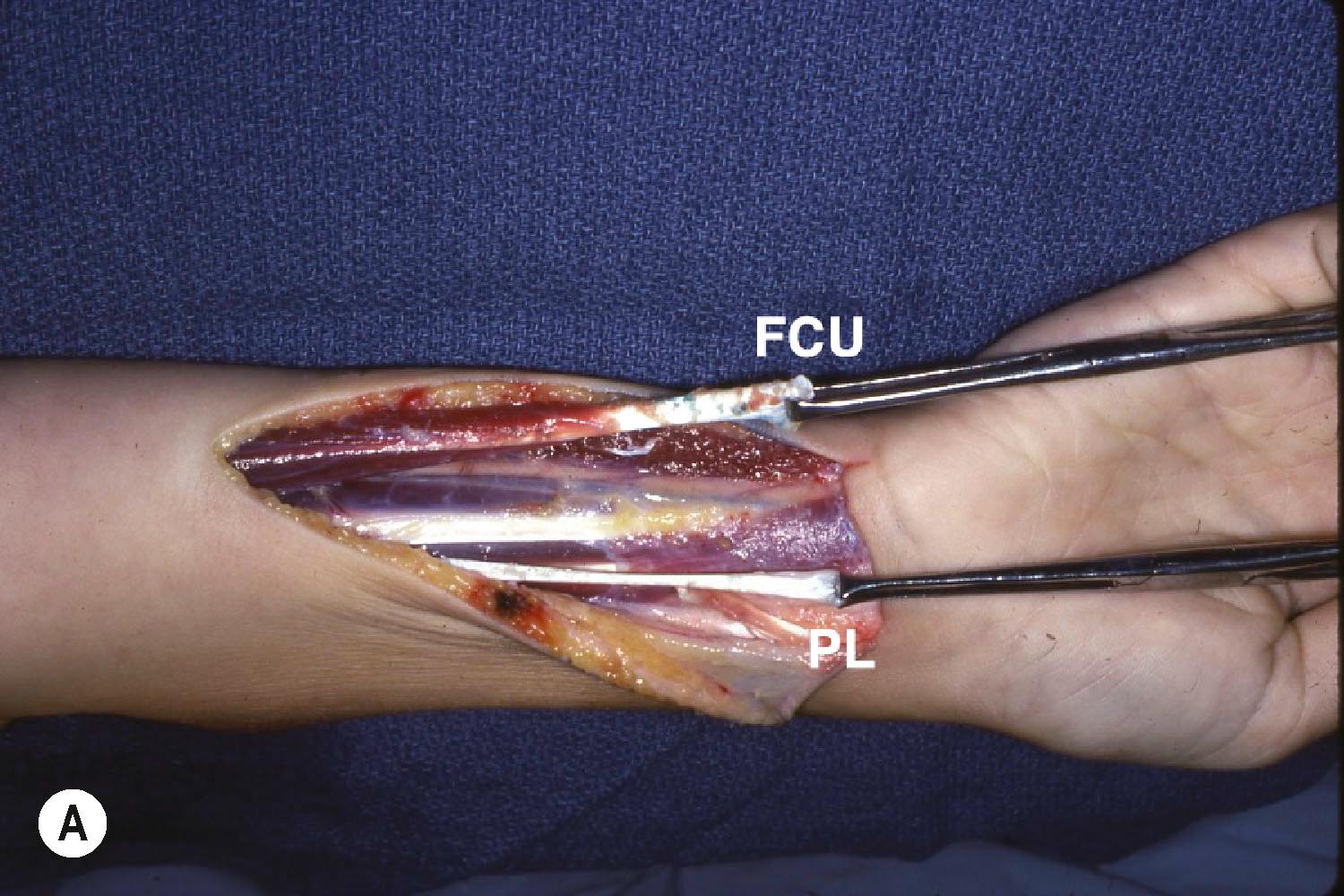
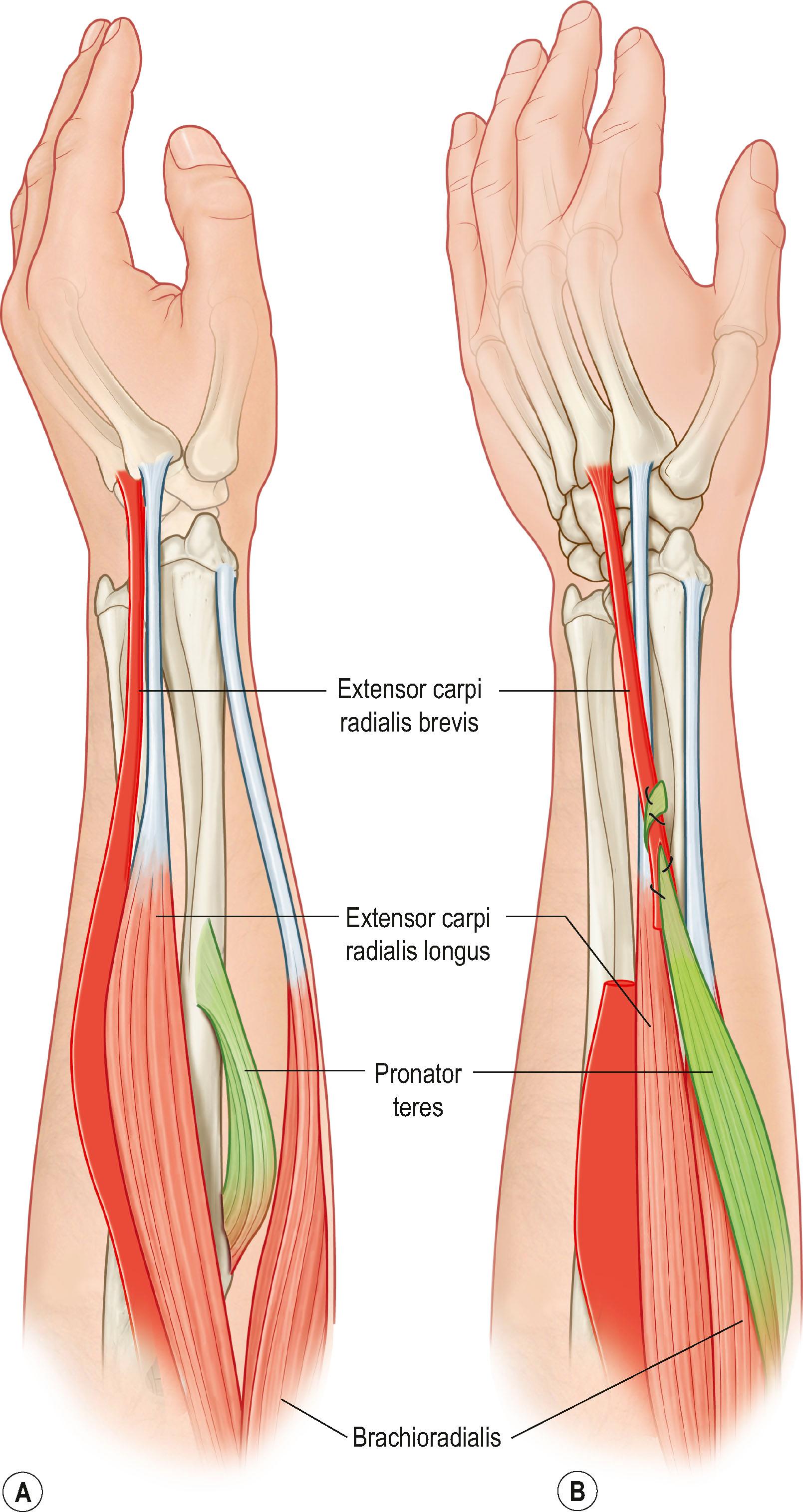
The proper tension in radial nerve tendon transfers should be tight enough to provide full extension of the wrist and digits but without restricting full flexion of the digits when the wrist is fully extended. The distal ends of the four EDC tendons to the index, long, ring, and small fingers are sutured to the FCU tendon proximal to the extensor retinaculum first. The extensor digiti minimi is usually not included unless there is still an extensor lag when proximal traction is applied to the EDC tendon to the small finger. With the fingers in full extension at the MCP joints, each individual EDC tendon is sutured to the FCU tendon at its resting length, starting with the index finger and finishing with the small finger. Alternatively, with all the fingers in full extension at the MCP joints, all four EDC tendons can be sutured together and the combined juncture sutured to the FCU tendon at its resting tension. Appropriate tension is then evaluated by checking that all four digits extend synchronously when the wrist is palmar flexed and most importantly that all four digits can be passively flexed into a fist when the wrist is extended. Next the palmaris longus and extensor pollicis longus tendons are interwoven over the anterior aspect of the distal forearm with the thumb in maximal extension and the wrist in neutral with the PL tendon at its resting tension. Finally, the last transfer is to weave the pronator teres at its resting tension through the ECRB tendon with the wrist in 45° of extension. The wrist is then immobilized in 45° of extension in a volar splint with the MCP joints positioned in slight flexion and the thumb in full extension and abduction.
Active flexion and extension of the fingers and thumb are started at 3.5 to 4 weeks and active exercises of the wrist begun at 5 weeks. Protective splinting is continued until 6–8 weeks postoperatively. Results have been uniformly good ( Fig. 25.7 ).
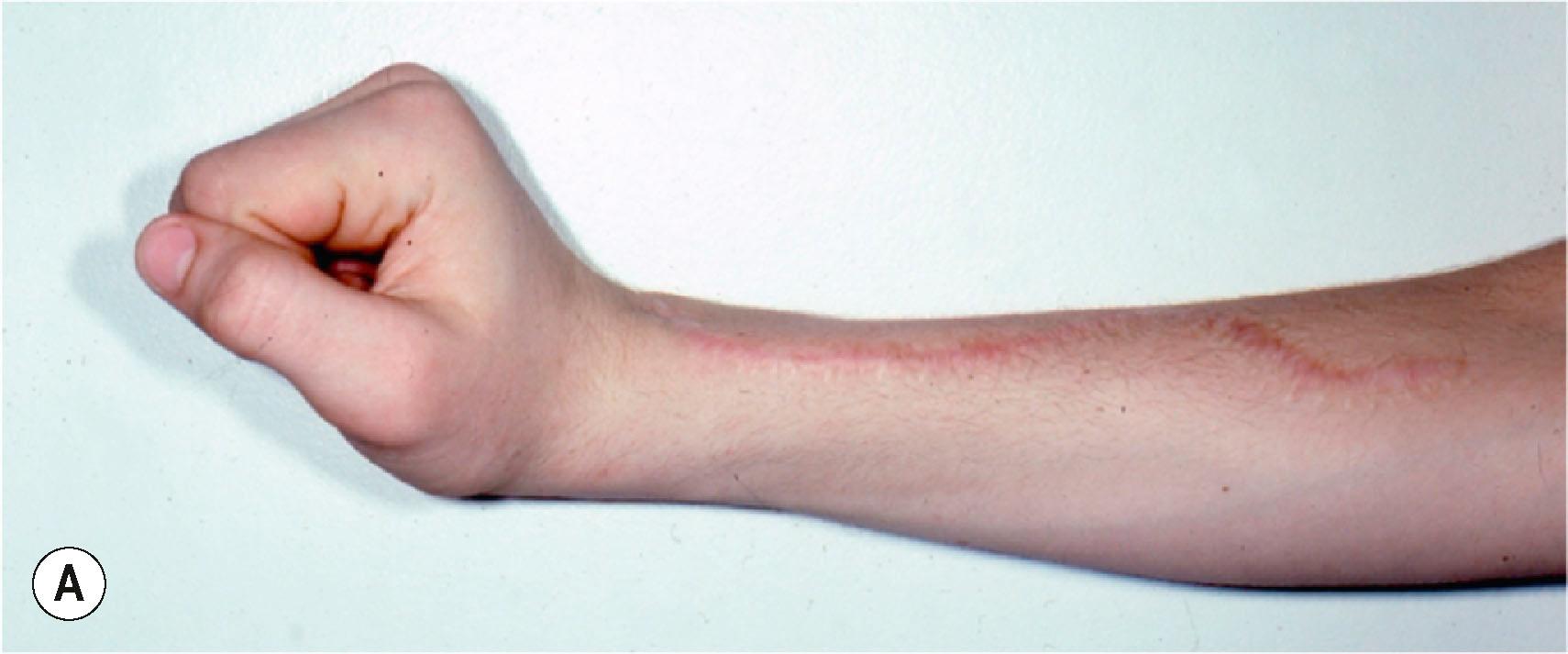
The skin incision begins from the radiovolar aspect of the mid-forearm and extends dorsally over the third and fourth extensor tendon compartments. The pronator teres is transferred to the extensor carpi radialis brevis and the palmaris longus is transferred to the extensor pollicis longus exactly as described in the standard FCU transfer. The FCR tendon is divided at the wrist crease and mobilized approximately to the level of the mid-forearm and re-routed around the radial border of the forearm. The four EDC tendons, and if necessary the EDM, may be woven through the donor FCR tendon proximal to the extensor retinaculum, but more usually the extensor tendons need to be re-routed superficial to the extensor retinaculum to obtain a straighter line of pull (see Fig. 25.8 ). To prevent a bulky tendon juncture, the small finger EDC and EDM may be sutured side-to-side to the ring finger EDC and the index finger EDC sutured side-to-side to the long finger EDC under appropriate tension. Then only the two EDC tendons to the long and ring fingers require weaving through the FCR tendon. As with the standard FCU transfer, these tendon junctures are performed with the wrist in neutral and the MCP joints in full extension with the FCR tendon at its resting length. Postoperative management is similar to that for the FCU transfer. Chandraprakasam et al . described a modification of the modified Jones transfer in which the pronator teres is transferred to ECRB; the FCR is transferred to the finger extensors and the palmaris longus transferred to EPL; all through a single incision along the radial aspect of the distal third of the forearm curving obliquely to end at Lister's tubercle.
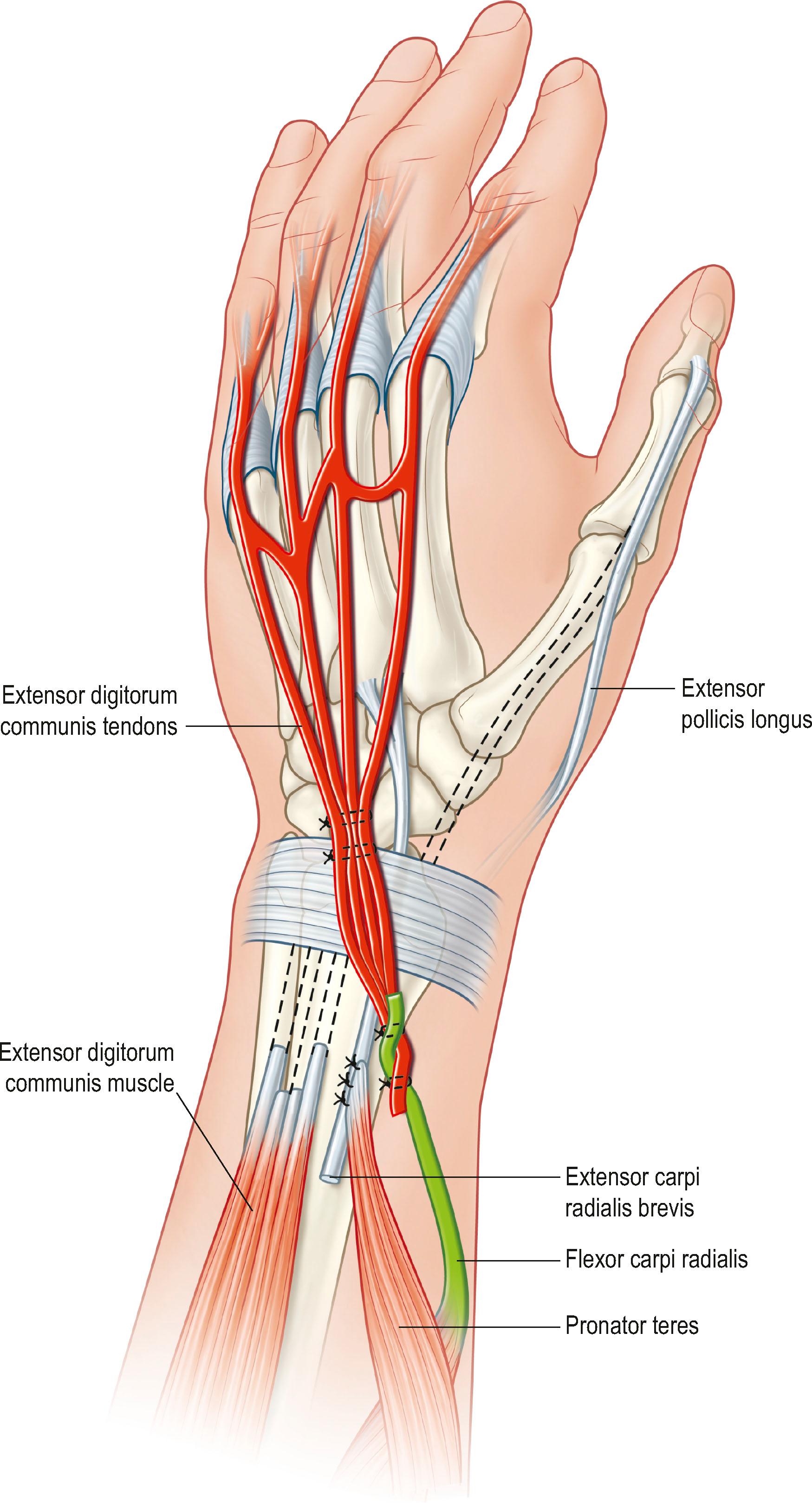
Boyes was the first to suggest that neither FCU nor FCR have sufficient amplitude (30 mm) to produce full excursion of the finger extensor tendons (50 mm) without the potential increase in amplitude obtained with the tenodesis effect of wrist flexion. He therefore advocated using the flexor digitorum superficialis (FDS) tendons to the long and ring fingers, which have an amplitude of 70 mm, to act as donor tendons to restore finger extension. The advantages of the Boyes transfer are that this transfer will potentially allow simultaneous wrist and finger extension; secondly, it may allow independent thumb and index finger extension; and finally, it does not weaken wrist flexion. However, the long and ring fingers are deprived of FDS function and this may result in weak grip. Harvesting of the FDS tendons may also result in the subsequent development of either a “swan-neck” deformity or a flexion contracture at the PIP joint.
The FDS tendons to the long and ring fingers are exposed between the A1 and A2 pulleys either through one transverse incision at the base of the fingers or two separate longitudinal incisions. The FDS tendons are divided just proximal to their decussation and then withdrawn proximally into a longitudinal incision over the anterior aspect of the middle third of the forearm. The tendon of pronator teres can be transected and re-routed through this same incision as described previously. Blunt dissection on either side of the flexor digitorum profundus (FDP) muscles allows a window to be excised in the interosseous membrane just proximal to the pronator quadratus (see Fig. 25.9 ). This window should be made as large as possible, at least 4 cm long and as wide as the interosseous space, so that the muscle bellies of the two FDS tendons can be passed through this window to minimize the development of adhesions. It is important to pass the FDS tendons of the long and ring fingers to their respective sides of the median nerve to prevent scissoring over the nerve and compression.

Thomsen and Rasmussen prefer to transfer the two FDS tendons around the radial and ulnar borders of the forearm through subcutaneous tunnels. Through a J-shaped incision passing transversely across the dorsum of the wrist and then extending proximally along the dorsum of the ulna, the extensor tendons are isolated as well as extensor carpi radialis brevis. In Boyes' original description, pronator teres was sutured to both ECRL and ECRB, but in order to prevent excessive radial deviation, pronator teres should only be woven end-to-end into ECRB with the wrist in 30° of extension. The long finger FDS is then passed to the radial side of the FDP muscles and the ring finger FDS to the ulnar side through the interosseous window into the dorsal incision. After transection of the EPL and EIP tendons, they are woven end-to-end into the long finger FDS tendon. Similarly, the transected EDC tendons to the index, long, ring, and small fingers are woven end-to-end into the ring finger FDS tendon, although this arrangement can be reversed. The tendon junctures are performed proximal to the extensor retinaculum with resting tension in the donor FDS tendons and full extension at the MCP joints.
If necessary, abductor pollicis longus (APL) is transected at its musculotendinous junction and passed through a subcutaneous tunnel from the base of the thumb into the volar forearm incision. Either palmaris longus or flexor carpi radialis are transected at the wrist crease and woven end-to-end with the APL tendon to provide abduction of the thumb and prevent a collapse deformity of the thumb metacarpal. The tourniquet should be deflated prior to the closure of the incisions because of the likelihood of bleeding from the anterior or posterior interosseous arteries.
Tendon transfers for radial nerve palsy are generally predictable. Tsuge described the evolution of his technique in 69 patients over a 25-year period. Using the FCU transfer and insertion of pronator teres into both ECRL and ECRB in the initial 41 patients, he reported “fairly satisfactory” results, but felt that there were three problems: development of radial deviation of the wrist, restriction of wrist flexion, and marginal thumb abduction. Because of these concerns, pronator teres was transferred only to ECRB and the FCR was transferred through the interosseous membrane for finger extension, leaving the FCU intact leading to good results in 24 of 27 cases. A long-term functional study of the FCU transfer in six patients by Raskin and Wilgis revealed adequate wrist motion and power to perform daily activities, and a work-simulation protocol showed patients were able to perform tasks without significant difficulty. Problems of inadequate ulnar deviation, grip strength, and wrist instability were not seen. A subjective outcome study by Riordan also revealed satisfaction with the standard FCU transfer. Long-term evaluation of the FCU transfer for radial nerve palsy at a mean follow-up of 9.5 years revealed 11 excellent, two good, one fair, and one bad result, with the main problems being loss of power grip and development of a radial deviation deformity. This resulted in an evolution in these authors’ technique to use pronator teres to restore wrist extension, FCR to restore finger extension, and palmaris longus to restore thumb extension with tenodesis of the abductor pollicis longus to brachioradialis to restore thumb abduction. Gousheh and Arasteh transferred only the FCU to the finger extensors and EPL in 108 patients. At a mean follow-up of 4 years, wrist extension was less than the opposite side, but extension of the fingers was similar to the normal hand and most patients were able to return to their previous job. According to the authors, there was no obvious difference between the results using a single FCU tendon transfer compared to their previous results using the conventional three tendon transfers for reconstruction of radial nerve palsy. Yavari et al . compared 33 patients who underwent only a single FCU transfer with 17 patients who underwent standard triple transfers using pronator teres, FCU, and palmaris longus, and found no significant difference in range of motion of the MCP, PIP, and DIP joints. Altintas et al . compared the long-term results after tendon transfers for radial nerve palsy, using the FCU in 58 patients and the FCR in 19 patients. Wrist extension averaged 73% of the opposite side, finger extension 32%, and thumb extension 80%. Grip strength was reduced to 49% and pinch strength to 28% of the opposite hand and the mean total DASH score was 16. Eighty-nine percent of patients remained employed after tendon transfers for radial nerve palsy.
Chuinard et al . studied 21 patients who had undergone the Boyes FDS transfers with excellent results in 10, good in six, and only a fair result in five patients. Subjectively, 13 patients felt that they had obtained an excellent result and eight a good result. Complications requiring a second procedure were reported in five patients and included adhesions, dehiscence of the transfer, MCP and wrist extension contractures, and problems with correct tensioning of the transfers. A report by Fujiwara of 13 patients with radial nerve palsy and five patients with PIN palsy documented generally good results with the Boyes transfers. No patient in either of these studies developed postoperative median nerve compression despite the potential for this complication with this transfer. Krishnan and Schackert evaluated the function of 29 patients who had undergone a Boyes transfer of the FDS tendons to the long and ring fingers through the interosseous membrane for radial nerve palsy. Near-normal wrist extension was achieved in 22 of 25 patients. Finger extension simultaneously with wrist extension was achieved in 12 patients, but in 17 patients full finger extension was only possible with the wrist in neutral. Selective extension of the index finger and thumb powered by the FDS tendon from the long finger was achieved in all patients.
All three techniques have been reported to yield good results, but there are few quantitative studies to substantiate the reported outcomes, and no prospective comparison of the three different techniques. Moussavi et al . retrospectively compared the three donor tendons FCU, FCR, and FDS to restore finger extension in 41 patients with radial nerve palsy and observed no difference in range of motion, DASH scores or overall satisfaction. The FCU transfer is perhaps the simplest technique and provides reproducibly good results in patients with radial nerve palsy.
Become a Clinical Tree membership for Full access and enjoy Unlimited articles
If you are a member. Log in here